6.6: Graph Quadratic Functions Using Properties
- Last updated
- Save as PDF
- Page ID
- 29079
\( \newcommand{\vecs}[1]{\overset { \scriptstyle \rightharpoonup} {\mathbf{#1}} } \)
\( \newcommand{\vecd}[1]{\overset{-\!-\!\rightharpoonup}{\vphantom{a}\smash {#1}}} \)
\( \newcommand{\id}{\mathrm{id}}\) \( \newcommand{\Span}{\mathrm{span}}\)
( \newcommand{\kernel}{\mathrm{null}\,}\) \( \newcommand{\range}{\mathrm{range}\,}\)
\( \newcommand{\RealPart}{\mathrm{Re}}\) \( \newcommand{\ImaginaryPart}{\mathrm{Im}}\)
\( \newcommand{\Argument}{\mathrm{Arg}}\) \( \newcommand{\norm}[1]{\| #1 \|}\)
\( \newcommand{\inner}[2]{\langle #1, #2 \rangle}\)
\( \newcommand{\Span}{\mathrm{span}}\)
\( \newcommand{\id}{\mathrm{id}}\)
\( \newcommand{\Span}{\mathrm{span}}\)
\( \newcommand{\kernel}{\mathrm{null}\,}\)
\( \newcommand{\range}{\mathrm{range}\,}\)
\( \newcommand{\RealPart}{\mathrm{Re}}\)
\( \newcommand{\ImaginaryPart}{\mathrm{Im}}\)
\( \newcommand{\Argument}{\mathrm{Arg}}\)
\( \newcommand{\norm}[1]{\| #1 \|}\)
\( \newcommand{\inner}[2]{\langle #1, #2 \rangle}\)
\( \newcommand{\Span}{\mathrm{span}}\) \( \newcommand{\AA}{\unicode[.8,0]{x212B}}\)
\( \newcommand{\vectorA}[1]{\vec{#1}} % arrow\)
\( \newcommand{\vectorAt}[1]{\vec{\text{#1}}} % arrow\)
\( \newcommand{\vectorB}[1]{\overset { \scriptstyle \rightharpoonup} {\mathbf{#1}} } \)
\( \newcommand{\vectorC}[1]{\textbf{#1}} \)
\( \newcommand{\vectorD}[1]{\overrightarrow{#1}} \)
\( \newcommand{\vectorDt}[1]{\overrightarrow{\text{#1}}} \)
\( \newcommand{\vectE}[1]{\overset{-\!-\!\rightharpoonup}{\vphantom{a}\smash{\mathbf {#1}}}} \)
\( \newcommand{\vecs}[1]{\overset { \scriptstyle \rightharpoonup} {\mathbf{#1}} } \)
\( \newcommand{\vecd}[1]{\overset{-\!-\!\rightharpoonup}{\vphantom{a}\smash {#1}}} \)
\(\newcommand{\avec}{\mathbf a}\) \(\newcommand{\bvec}{\mathbf b}\) \(\newcommand{\cvec}{\mathbf c}\) \(\newcommand{\dvec}{\mathbf d}\) \(\newcommand{\dtil}{\widetilde{\mathbf d}}\) \(\newcommand{\evec}{\mathbf e}\) \(\newcommand{\fvec}{\mathbf f}\) \(\newcommand{\nvec}{\mathbf n}\) \(\newcommand{\pvec}{\mathbf p}\) \(\newcommand{\qvec}{\mathbf q}\) \(\newcommand{\svec}{\mathbf s}\) \(\newcommand{\tvec}{\mathbf t}\) \(\newcommand{\uvec}{\mathbf u}\) \(\newcommand{\vvec}{\mathbf v}\) \(\newcommand{\wvec}{\mathbf w}\) \(\newcommand{\xvec}{\mathbf x}\) \(\newcommand{\yvec}{\mathbf y}\) \(\newcommand{\zvec}{\mathbf z}\) \(\newcommand{\rvec}{\mathbf r}\) \(\newcommand{\mvec}{\mathbf m}\) \(\newcommand{\zerovec}{\mathbf 0}\) \(\newcommand{\onevec}{\mathbf 1}\) \(\newcommand{\real}{\mathbb R}\) \(\newcommand{\twovec}[2]{\left[\begin{array}{r}#1 \\ #2 \end{array}\right]}\) \(\newcommand{\ctwovec}[2]{\left[\begin{array}{c}#1 \\ #2 \end{array}\right]}\) \(\newcommand{\threevec}[3]{\left[\begin{array}{r}#1 \\ #2 \\ #3 \end{array}\right]}\) \(\newcommand{\cthreevec}[3]{\left[\begin{array}{c}#1 \\ #2 \\ #3 \end{array}\right]}\) \(\newcommand{\fourvec}[4]{\left[\begin{array}{r}#1 \\ #2 \\ #3 \\ #4 \end{array}\right]}\) \(\newcommand{\cfourvec}[4]{\left[\begin{array}{c}#1 \\ #2 \\ #3 \\ #4 \end{array}\right]}\) \(\newcommand{\fivevec}[5]{\left[\begin{array}{r}#1 \\ #2 \\ #3 \\ #4 \\ #5 \\ \end{array}\right]}\) \(\newcommand{\cfivevec}[5]{\left[\begin{array}{c}#1 \\ #2 \\ #3 \\ #4 \\ #5 \\ \end{array}\right]}\) \(\newcommand{\mattwo}[4]{\left[\begin{array}{rr}#1 \amp #2 \\ #3 \amp #4 \\ \end{array}\right]}\) \(\newcommand{\laspan}[1]{\text{Span}\{#1\}}\) \(\newcommand{\bcal}{\cal B}\) \(\newcommand{\ccal}{\cal C}\) \(\newcommand{\scal}{\cal S}\) \(\newcommand{\wcal}{\cal W}\) \(\newcommand{\ecal}{\cal E}\) \(\newcommand{\coords}[2]{\left\{#1\right\}_{#2}}\) \(\newcommand{\gray}[1]{\color{gray}{#1}}\) \(\newcommand{\lgray}[1]{\color{lightgray}{#1}}\) \(\newcommand{\rank}{\operatorname{rank}}\) \(\newcommand{\row}{\text{Row}}\) \(\newcommand{\col}{\text{Col}}\) \(\renewcommand{\row}{\text{Row}}\) \(\newcommand{\nul}{\text{Nul}}\) \(\newcommand{\var}{\text{Var}}\) \(\newcommand{\corr}{\text{corr}}\) \(\newcommand{\len}[1]{\left|#1\right|}\) \(\newcommand{\bbar}{\overline{\bvec}}\) \(\newcommand{\bhat}{\widehat{\bvec}}\) \(\newcommand{\bperp}{\bvec^\perp}\) \(\newcommand{\xhat}{\widehat{\xvec}}\) \(\newcommand{\vhat}{\widehat{\vvec}}\) \(\newcommand{\uhat}{\widehat{\uvec}}\) \(\newcommand{\what}{\widehat{\wvec}}\) \(\newcommand{\Sighat}{\widehat{\Sigma}}\) \(\newcommand{\lt}{<}\) \(\newcommand{\gt}{>}\) \(\newcommand{\amp}{&}\) \(\definecolor{fillinmathshade}{gray}{0.9}\)Learning Objectives
By the end of this section, you will be able to:
- Recognize the graph of a quadratic function
- Find the axis of symmetry and vertex of a parabola
- Find the intercepts of a parabola
- Graph quadratic functions using properties
- Solve maximum and minimum applications
Before you get started, take this readiness quiz.
- Graph the function \(f(x)=x^{2}\) by plotting points.
If you missed this problem, review Example 3.54. - Solve: \(2 x^{2}+3 x-2=0\).
If you missed this problem, review Example 6.45. - Evaluate \(-\frac{b}{2 a}\) when \(a=3\) and \(b=-6\).
If you missed this problem, review Example 1.21.
Recognize the Graph of a Quadratic Function
Previously we very briefly looked at the function \(f(x)=x^{2}\), which we called the square function. It was one of the first non-linear functions we looked at. Now we will graph functions of the form \(f(x)=a x^{2}+b x+c\) if \(a \neq 0\). We call this kind of function a quadratic function.
Definition \(\PageIndex{1}\)
A quadratic function, where \(a, b\), and \(c\) are real numbers and \(a≠0\), is a function of the form
\(f(x)=a x^{2}+b x+c\)
We graphed the quadratic function \(f(x)=x^{2}\) by plotting points.
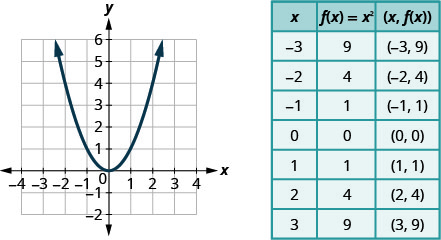
Every quadratic function has a graph that looks like this. We call this figure a parabola. Let’s practice graphing a parabola by plotting a few points.
Example \(\PageIndex{1}\)
Graph: \(f(x)=x^{2}-1\).
Solution:
We will graph the function by plotting points.
|
Choose integer values for \(x\), |
 |
| Plot the points, and then connect them with a smooth curve. The result will be the graph of the function \(f(x)=x^{2}-1\). |
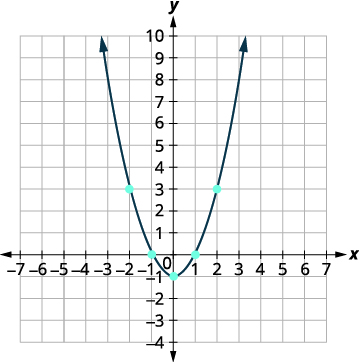 |
Exercise \(\PageIndex{1}\)
Graph \(f(x)=-x^{2}\).
- Answer
-
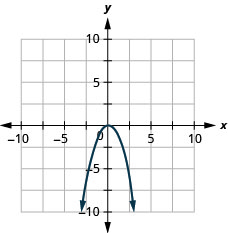
Exercise \(\PageIndex{2}\)
Graph \(f(x)=x^{2}-1\).
- Answer
-
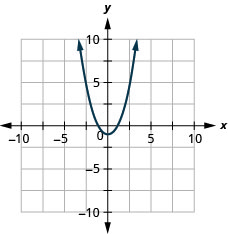
All graphs of quadratic functions of the form \(f(x)=a x^{2}+b x+c\) are parabolas that open upward or downward. See Figure 9.6.6
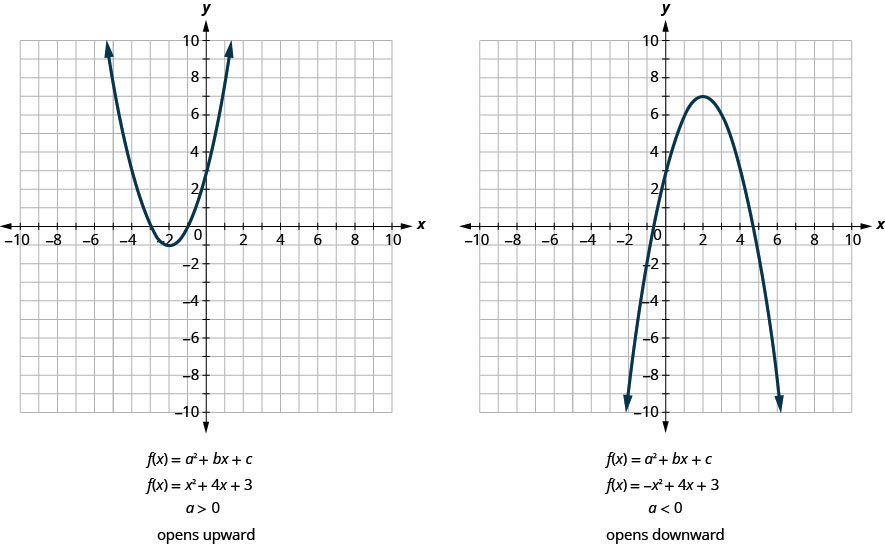
Notice that the only difference in the two functions is the negative sign before the quadratic term (\(x^{2}\) in the equation of the graph in Figure 9.6.6). When the quadratic term, is positive, the parabola opens upward, and when the quadratic term is negative, the parabola opens downward.
Definition \(\PageIndex{2}\)
Parabola Orientation
For the graph of the quadratic function \(f(x)=a x^{2}+b x+c\), if

Example \(\PageIndex{2}\)
Determine whether each parabola opens upward or downward:
- \(f(x)=-3 x^{2}+2 x-4\)
- \(f(x)=6 x^{2}+7 x-9\)
Solution:
a. Find the value of \(a\).

Since the \(a\) is negative, the parabola will open downward.
b. Find the value of \(a\).

Since the \(a\) is positive, the parabola will open upward.
Exercise \(\PageIndex{3}\)
Determine whether the graph of each function is a parabola that opens upward or downward:
- \(f(x)=2 x^{2}+5 x-2\)
- \(f(x)=-3 x^{2}-4 x+7\)
- Answer
-
- up
- down
Exercise \(\PageIndex{4}\)
Determine whether the graph of each function is a parabola that opens upward or downward:
- \(f(x)=-2 x^{2}-2 x-3\)
- \(f(x)=5 x^{2}-2 x-1\)
- Answer
-
- down
- up
Find the Axis of Symmetry and Vertex of a Parabola
Look again at Figure 9.6.10. Do you see that we could fold each parabola in half and then one side would lie on top of the other? The ‘fold line’ is a line of symmetry. We call it the axis of symmetry of the parabola.
We show the same two graphs again with the axis of symmetry.

The equation of the axis of symmetry can be derived by using the Quadratic Formula. We will omit the derivation here and proceed directly to using the result. The equation of the axis of symmetry of the graph of \(f(x)=a x^{2}+b x+c\) is \(x=-\frac{b}{2 a}\).
So to find the equation of symmetry of each of the parabolas we graphed above, we will substitute into the formula \(x=-\frac{b}{2 a}\).
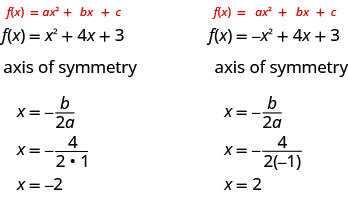
Notice that these are the equations of the dashed blue lines on the graphs.
The point on the parabola that is the lowest (parabola opens up), or the highest (parabola opens down), lies on the axis of symmetry. This point is called the vertex of the parabola.
We can easily find the coordinates of the vertex, because we know it is on the axis of symmetry. This means its
\(x\)-coordinate is \(-\frac{b}{2 a}\). To find the \(y\)-coordinate of the vertex we substitute the value of the \(x\)-coordinate into the quadratic function.

Axis of Symmetry and Vertex of a Parabola
The graph of the function \(f(x)=a x^{2}+b x+c\) is a parabola where:
- the axis of symmetry is the vertical line \(x=-\frac{b}{2 a}\).
- the vertex is a point on the axis of symmetry, so its \(x\)-coordinate is \(-\frac{b}{2 a}\)
- the \(y\)-coordinate of the vertex is found by substituting \(x=-\frac{b}{2 a}\) into the quadratic equation.
Example \(\PageIndex{3}\)
For the graph of \(f(x)=3 x^{2}-6 x+2\) find:
- the axis of symmetry
- the vertex
Solution:
a.
 |
|
| The axis of symmetry is the vertical line \(x=-\frac{b}{2 a}\). | |
| Substitute the values \(a,b\) into the equation. | \(x=-\frac{-6}{2 \cdot 3}\) |
| Simplify. | \(x=1\) |
| The axis of symmetry is the line \(x=1\). |
b.
| \(f(x)=3 x^{2}-6 x+2\) | |
| The vertex is a point on the line of symmetry, so its \(x\)-coordinate will be \(x=1\). Find \(f(1)\). |  |
| Simplify. |  |
| The result is the \(y\)-coordinate. | \(f(1)=-1\) |
| The vertex is \((1,-1)\). |
Exercise \(\PageIndex{5}\)
For the graph of \(f(x)=2 x^{2}-8 x+1\) find:
- the axis of symmetry
- the vertex
- Answer
-
- \(x=2\)
- \((2,-7)\)
Exercise \(\PageIndex{6}\)
For the graph of \(f(x)=2 x^{2}-4 x-3\) find:
- the axis of symmetry
- the vertex
- Answer
-
- \(x=1\)
- \((1,-5)\)
Find the Intercepts of a Parabola
When we graphed linear equations, we often used the \(x\)- and \(y\)-intercepts to help us graph the lines. Finding the coordinates of the intercepts will help us to graph parabolas, too.
Remember, at the \(y\)-intercept the value of \(x\) is zero. So to find the \(y\)-intercept, we substitute \(x=0\) into the function.
Let’s find the \(y\)-intercepts of the two parabolas shown in Figure 9.6.20.
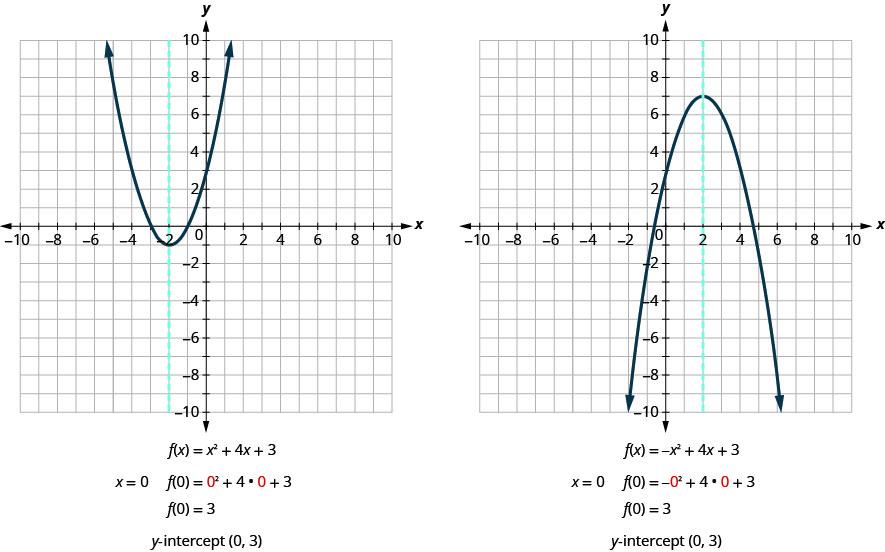
An \(x\)-intercept results when the value of \(f(x)\) is zero. To find an \(x\)-intercept, we let \(f(x)=0\). In other words, we will need to solve the equation \(0=a x^{2}+b x+c\) for \(x\).
\(\begin{aligned} f(x) &=a x^{2}+b x+c \\ 0 &=a x^{2}+b x+c \end{aligned}\)
Solving quadratic equations like this is exactly what we have done earlier in this chapter!
We can now find the \(x\)-intercepts of the two parabolas we looked at. First we will find the \(x\)-intercepts of the parabola whose function is \(f(x)=x^{2}+4 x+3\).
| \(f(x)=x^{2}+4 x+3\) | |
| Let \(f(x)=0\). | \(\color{red}0\color{black}=x^{2}+4 x+3\) |
| Factor. | \(0=(x+1)(x+3)\) |
| Use the Zero Product Property. | \(x+1=0 \quad x+3=0\) |
| Solve. | \(x=-1 \quad x=-3\) |
| The \(x\)-intercepts are \((-1,0)\) and \((-3,0)\). |
Now we will find the \(x\)-intercepts of the parabola whose function is \(f(x)=-x^{2}+4 x+3\).
| \(f(x)=-x^{2}+4 x+3\) | |
| Let \(f(x)=0\). | \(\color{red}0 \color{black}=-x^{2}+4 x+3\) |
| This quadratic does not factor, so we use the Quadratic Formula. | \(x=\frac{-b \pm \sqrt{b^{2}-4 a c}}{2 a}\) |
| \(a=-1, b=4, c=3\) | \(x=\frac{-4 \pm \sqrt{4^{2}-4(-1)(3)}}{2(-1)}\) |
| Simplify. | \(x=\frac{-4 \pm \sqrt{28}}{-2}\) |
| \(x=\frac{-4 \pm 2 \sqrt{7}}{-2}\) | |
| \(x=\frac{-2(2 \pm \sqrt{7})}{-2}\) | |
| \(x=2 \pm \sqrt{7}\) | |
| The \(x\)-intercepts are \((2+\sqrt{7}, 0)\) and \((2-\sqrt{7}, 0)\). |
We will use the decimal approximations of the \(x\)-intercepts, so that we can locate these points on the graph,
\((2+\sqrt{7}, 0) \approx(4.6,0) \quad(2-\sqrt{7}, 0) \approx(-0.6,0)\)
Do these results agree with our graphs? See Figure 9.6.34
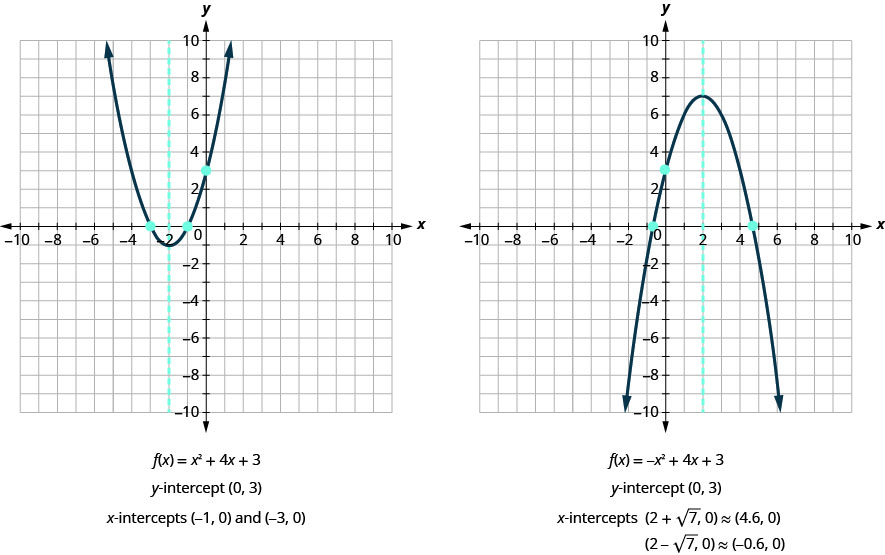
Find the Intercepts of a Parabola
To find the intercepts of a parabola whose function is \(f(x)=a x^{2}+b x+c\):
\(y\)-intercept
Let \(x=0\) and solve for \(f(x)\).
\(x\)-intercepts
Let \(f(x)=0\) and solve for \(x\)
Example \(\PageIndex{4}\)
Find the intercepts of the parabola whose function is \(f(x)=x^{2}-2 x-8\).
Solution:
| To find the \(y\)-intercept, let \(x=0\) and solve for \(f(x)\). | \(f(x)=x^{2}-2 x-8\) |
| \(f(0)=\color{red}0\color{black}^{2}-2 \cdot \color{red}0 \color{black}-8\) | |
| \(f(0)=-8\) | |
| When \(x=0\), then \(f(0)=-8\). The \(y\)-intercept is the point \((0,-8)\). | |
| To find the \(x\)-intercept, let \(f(x)=0\) and solve for \(x\). | \(f(x)=x^{2}-2 x-8\) |
| \(0=x^{2}-2 x-8\) | |
| Solve by factoring. | \(0=(x-4)(x+2)\) |
| \(0=x-4 \quad 0=x+2\) | |
| \(4=x \quad-2=x\) | |
| When \(f(x)=0\), then \(x=4\) or \(x=-2\). The \(x\)-intercepts are the points \((4,0)\) and \((-2,0)\). |
Exercise \(\PageIndex{7}\)
Find the intercepts of the parabola whose function is \(f(x)=x^{2}+2 x-8\).
- Answer
-
\(y\) -intercept: \((0,-8) x\) -intercepts \((-4,0),(2,0)\)
Exercise \(\PageIndex{8}\)
Find the intercepts of the parabola whose function is \(f(x)=x^{2}-4 x-12\).
- Answer
-
\(y\) -intercept: \((0,-12) x\) -intercepts \((-2,0),(6,0)\)
In this chapter, we have been solving quadratic equations of the form \(a x^{2}+b x+c=0\). We solved for \(x\) and the results were the solutions to the equation.
We are now looking at quadratic functions of the form \(f(x)=a x^{2}+b x+c\). The graphs of these functions are parabolas. The \(x\)-intercepts of the parabolas occur where \(f(x)=0\).
For example:
Quadratic equation
\(\begin{aligned}x^{2}-2 x-15 & =0\quad \text{Let}\:f(x)=0 \\ (x-5)(x+3) &=0 \\ x-5=0\:\:x+3 & =0 \\ x=5\:\:\:x&=-3\end{aligned}\)
Quadratic function
\(\begin{aligned} f(x) &=x^{2}-2 x-15 \\ 0 &=x^{2}-2 x-15 \\ 0 &=(x-5)(x+3) \\ x-5 &=0 \quad x+3=0 \\ x &=5 \quad x=-3 \\(5,0) & \text { and }(-3,0) \\& x\text { -intercepts } \end{aligned}\)
The solutions of the quadratic function are the \(x\) values of the \(x\)-intercepts.
Earlier, we saw that quadratic equations have \(2, 1\), or \(0\) solutions. The graphs below show examples of parabolas for these three cases. Since the solutions of the functions give the \(x\)-intercepts of the graphs, the number of \(x\)-intercepts is the same as the number of solutions.
Previously, we used the discriminant to determine the number of solutions of a quadratic function of the form \(a x^{2}+b x+c=0\). Now we can use the discriminant to tell us how many \(x\)-intercepts there are on the graph.

Before you to find the values of the \(x\)-intercepts, you may want to evaluate the discriminant so you know how many solutions to expect.
Example \(\PageIndex{5}\)
Find the intercepts of the parabola for the function \(f(x)=5 x^{2}+x+4\).
Solution:
 |
|
| To find the \(y\)-intercept, let \(x=0\) and solve for \(f(x)\). |  |
 |
|
| When \(x=0\), then \(f(0)=4\). The \(y\)-intercept is the point \((0,4)\). | |
| To find the \(x\)-intercept, let \(f(x)=0\) and solve for \(x\). |  |
 |
|
| Find the value of the discriminant to predict the number of solutions which is also the number of \(x\)-intercepts. | |
| \(\begin{array}{c}{b^{2}-4 a c} \\ {1^{2}-4 \cdot 5 \cdot 4} \\ {1-80} \\ {-79}\end{array}\) | |
|
Since the value of the discriminant is negative, there is no real solution to the equation. There are no \(x\)-intercepts. |
Exercise \(\PageIndex{9}\)
Find the intercepts of the parabola whose function is \(f(x)=3 x^{2}+4 x+4\).
- Answer
-
\(y\)-intercept: \((0,4)\) no \(x\)-intercept
Exercise \(\PageIndex{10}\)
Find the intercepts of the parabola whose function is \(f(x)=x^{2}-4 x-5\)
- Answer
-
\(y\)-intercept: \((0,-5)\) \(x\)-intercepts \((-1,0),(5,0)\)
Graph Quadratic Functions Using Properties
Now we have all the pieces we need in order to graph a quadratic function. We just need to put them together. In the next example we will see how to do this.
Example \(\PageIndex{6}\) How to Graph a Quadratic Function Using Properties
Graph \(f(x)=x^{2}-6x+8\) by using its properties.
Solution:
| Step 1: Determine whether the parabola opens upward or downward. |
Look \(a\) in the equation \(f(x)=x^{2}-6x+8\) Since \(a\) is positive, the parabola opens upward. |
\(f(x)=x^{2}-6x+8\) \(\color{red}{a=1, b=-6, c=8}\) The parabola opens upward. |
| Step 2: Find the axis of symmetry. |
\(f(x)=x^{2}-6x+8\) The axis of symmetry is the line \(x=-\frac{b}{2 a}\). |
Axis of Symmetry \(x=-\frac{b}{2 a}\) \(x=-\frac{(-6)}{2 \cdot 1}\) \(x=3\) The axis of symmetry is the line \(x=3\). |
| Step 3: Find the vertex. | The vertex is on the axis of symmetry. Substitute \(x=3\) into the function. |
Vertex \(f(x)=x^{2}-6x+8\) \(f(3)=(\color{red}{3}\color{black}{)}^{2}-6(\color{red}{3}\color{black}{)}+8\) \(f(3)=-1\) The vertex is \((3,-1)\). |
| Step 4: Find the \(y\)-intercept. Find the point symmetric to the \(y\)-intercept across the axis of symmetry. |
We find \(f(0)\). We use the axis of symmetry to find a point symmetric to the \(y\)-intercept. The \(y\)-intercept is \(3\) units left of the axis of symmetry, \(x=3\). A point \(3\) units to the right of the axis of symmetry has \(x=6\). |
\(y\)-intercept \(f(x)=x^{2}-6 x+8\) \(f(0)=(\color{red}{0}\color{black}{)}^{2}-6(\color{red}{0}\color{black}{)}+8\) \(f(0)=8\) The \(y\)-intercept is \((0,8)\). Point symmetric to \(y\)-intercept: The point is \((6,8)\). |
| Step 5: Find the \(x\)-intercepts. Find additional points if needed. |
We solve \(f(x)=0\). We can solve this quadratic equation by factoring. |
\(x\)-intercepts \(f(x)=x^{2}-6 x+8\) \(\color{red}{0}\color{black}{=}x^{2}-6x+8\) \(\color{red}{0}\color{black}{=}(x-2)(x-4)\) \(x=2 or x=4\) The \(x\)-intercepts are \((2,0)\) and \((4,0)\). |
| Step 6: Graph the parabola. | We graph the vertex, intercepts, and the point symmetric to the \(y\)-intercept. We connect these \(5\) points to sketch the parabola. | .png?revision=1) |
Exercise \(\PageIndex{11}\)
Graph \(f(x)=x^{2}+2x-8\) by using its properties.
- Answer
-
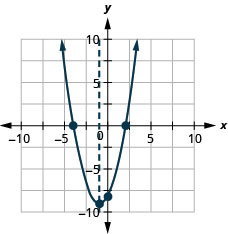
Exercise \(\PageIndex{12}\)
Graph \(f(x)=x^{2}-8x+12\) by using its properties.
- Answer
-
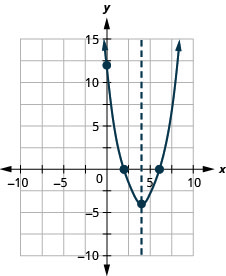
We list the steps to take in order to graph a quadratic function here.
To Graph a Quadratic Function Using Properties
- Determine whether the parabola opens upward or downward.
- Find the equation of the axis of symmetry.
- Find the vertex.
- Find the \(y\)-intercept. Find the point symmetric to the \(y\)-intercept across the axis of symmetry.
- Find the \(x\)-intercepts. Find additional points if needed.
- Graph the parabola.
We were able to find the \(x\)-intercepts in the last example by factoring. We find the \(x\)-intercepts in the next example by factoring, too.
Example \(\PageIndex{7}\)
Graph \(f(x)=-x^{2}+6 x-9\) by using its properties.
Solution:
 |
|
| Since \(a\) is \(-1\), the parabola opens downward. | |
 |
|
| To find the equation of the axis of symmetry, use \(x=-\frac{b}{2 a}\). | \(x=-\frac{b}{2 a}\) |
| \(x=-\frac{6}{2(-1)}\) | |
| \(x=3\) | |
|
The axis of symmetry is \(x=3\). The vertex is on the line \(x=3\). |
|
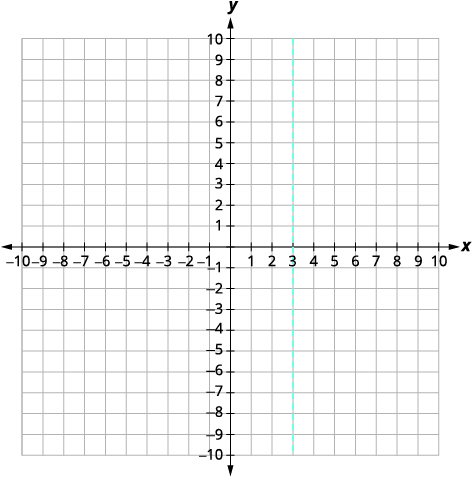 |
|
| Find \(f(3)\). | \(f(x)=-x^{2}+6 x-9\) |
 |
|
| \(f(3)=-9+18-9\) | |
| \(f(3)=0\) | |
| The vertex is \((3,0)\). | |
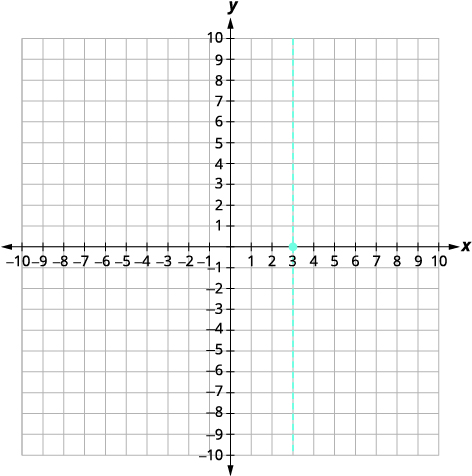 |
|
| The \(y\)-intercept occurs when \(x=0\). Find \(f(0)\). | \(f(x)=-x^{2}+6 x-9\) |
| Substitute \(x=0\). |  |
| Simplify. | \(f(0)=-9\) |
| The point \((0,-9)\) is three units to the left of the line of symmetry. The point three units to the right of the line of symmetry is \((6,-9)\). | 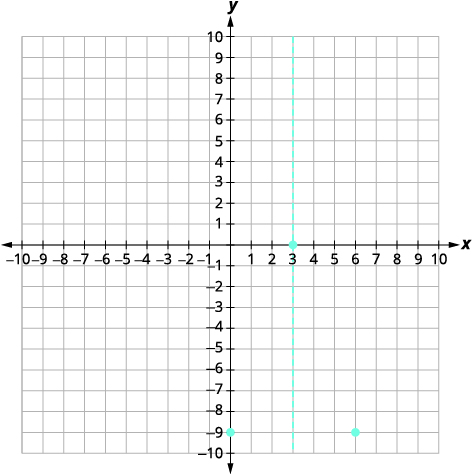 |
| Point symmetric to the \(y\)-intercept is \((6,-9)\) | |
| The \(x\)-intercept occurs when \(f(x)=0\). |  |
| Find \(f(x)=0\). |  |
| Factor the GCF. |  |
| Factor the trinomial. |  |
| Solve for \(x\). |  |
| Connect the points to graph the parabola. | 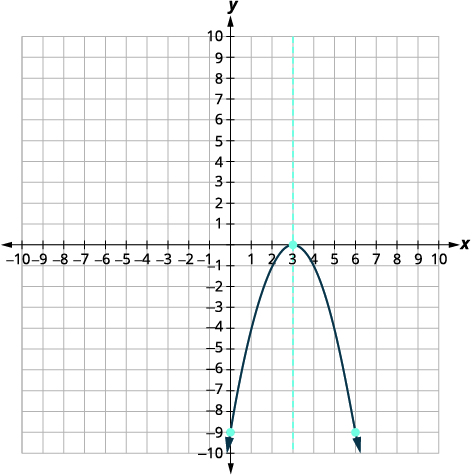 |
Exercise \(\PageIndex{13}\)
Graph \(f(x)=3 x^{2}+12 x-12\) by using its properties.
- Answer
-
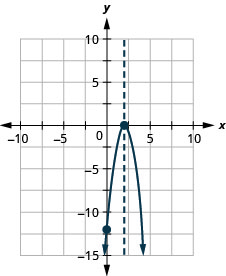
Exercise \(\PageIndex{14}\)
Graph \(f(x)=4 x^{2}+24 x+36\) by using its properties.
- Answer
-
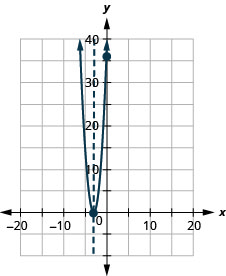
For the graph of \(f(x)=-x^{2}+6 x-9\), the vertex and the \(x\)-intercept were the same point. Remember how the discriminant determines the number of solutions of a quadratic equation? The discriminant of the equation \(0=-x^{2}+6x-9\) is \(0\), so there is only one solution. That means there is only one \(x\)-intercept, and it is the vertex of the parabola.
How many \(x\)-intercepts would you expect to see on the graph of \(f(x)=x^{2}+4 x+5\)?
Example \(\PageIndex{8}\)
Graph \(f(x)=x^{2}+4 x+5\) by using its properties.
Solution:
 |
|
| Since \(a\) is \(-1\), the parabola opens downward. | |
 |
|
| To find the equation of the axis of symmetry, use \(x=-\frac{b}{2 a}\). |  |
 |
|
 |
|
|
The equation of the axis of symmetry is \(x=-2). |
|
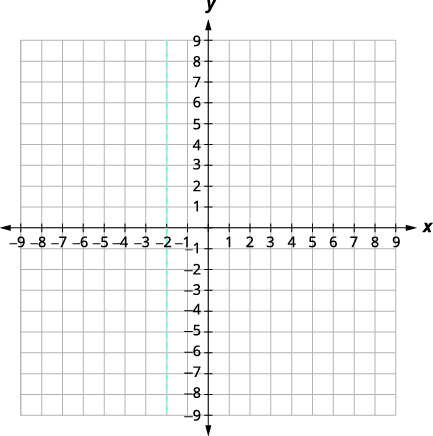 |
|
| The vertex is on the line \(x=-2\). | |
| Find \(f(x)\) when \(x=-2\). |  |
 |
|
 |
|
 |
|
|
The vertex is \((-2,1)\). |
|
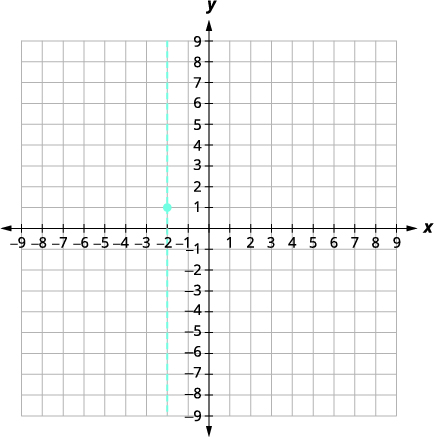 |
|
| The \(y\)-intercept occurs when \(x=0\). |  |
| Find \(f(0)\). |  |
| Simplify. |  |
| The \(y\)-intercept is \((0,5)\). | |
| The point \((-4,5)\) is two units to the left of the line of symmetry. The point to units to the right of the line of symmetry is \((0,5)\. | 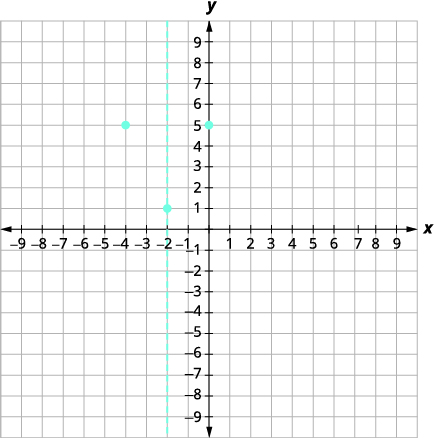 |
| Point symmetric to the \(y\)-intercept is \((-4,5)\). | |
| The \(x\)-intercept occurs when \(f(x)=0\). |  |
| Find \(f(x)=0\). |  |
| Test the discriminant. | |
 |
|
 |
|
 |
|
 |
|
| Since the value of the discriminant is negative, there is no real solution and so no \(x\)-intercept. | |
| Connect the points to graph the parabola. You may want to choose two more points for greater accuracy. | 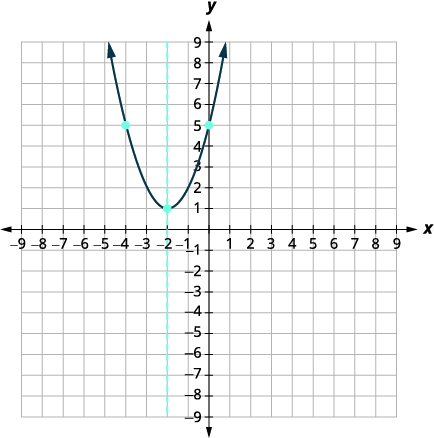 |
Exercise \(\PageIndex{15}\)
Graph \(f(x)=x^{2}-2 x+3\) by using its properties.
- Answer
-
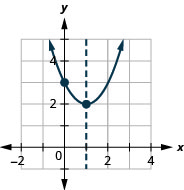
Exercise \(\PageIndex{16}\)
Graph \(f(x)=-3x^{2}-6 x-4\) by using its properties.
- Answer
-
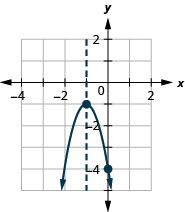
Finding the \(y\)-intercept by finding \(f(0)\) is easy, isn't it? Sometimes we need to use the Quadratic Formula to find the \(x\)-intercepts.
Example \(\PageIndex{9}\)
Graph \(f(x)=2 x^{2}-4 x-3\) by using its properties.
Solution:
 |
|
|
Since \(a\) is \(2\), the parabola opens upward. |
 |
| To find the equation of the axis of symmetry, use \(x=-\frac{b}{2 a}\). | \(x=-\frac{b}{2 a}\) |
| \(x=-\frac{-4}{2 \cdot 2}\) | |
| \(x=1\) | |
| The equation of the axis of symmetry is \(x=1\). | |
| The vertex is on the line \(x=1\). | \(f(x)=2 x^{2}-4 x-3\) |
| Find \(f(1)\). |  |
| \(f(1)=2-4-3\) | |
| \(\f(1)=-5) | |
| The vertex is \((1,-5)\). | |
| The \(y\)-intercept occurs when \(x=0\). | \(f(x)=2 x^{2}-4 x-3\) |
| Find \(f(0)\). |  |
| Simplify. | \(f(0)=-3\) |
| The \(y\)-intercept is \((0,-3)\). | |
| The point \((0,-3)\) is one unit to the left of the line of symmetry. | Point symmetric to the \(y\)-intercept is \((2,-3)\) |
| The point one unit to the right of the line of symmetry is \((2,3)\). | |
| The \(x\)-intercept occurs when \(y=0\). | \(f(x)=2 x^{2}-4 x-3\) |
| Find \(f(x)=0\). |  |
| Use the Quadratic Formula. | \(x=\frac{-b \pm \sqrt{b^{2}-4 a c}}{2 a}\) |
| Substitute in the values of \(a,b\) and \(c\). | \(x=\frac{-(-4) \pm \sqrt{(-4)^{2}-4(2)(3)}}{2(2)}\) |
| Simplify. | \(x=\frac{-4 \pm \sqrt{16+24}}{4}\) |
| Simplify inside the radical. | \(x=\frac{4 \pm \sqrt{40}}{4}\) |
| Simplify the radical. | \(x=\frac{4 \pm 2 \sqrt{10}}{4}\) |
| Factor the GCF. | \(x=\frac{2(2 \pm \sqrt{10})}{4}\) |
| Remove common factors. | \(x=\frac{2 \pm \sqrt{10}}{2}\) |
| Write as two equations. | \(x=\frac{2+\sqrt{10}}{2}, \quad x=\frac{2-\sqrt{10}}{2}\) |
| Approximate the values. | \(x \approx 2.5, \quad x \approx-0.6\) |
| The approximate values of the \(x\)-intercepts are \((2.5,0)\) and \((-0.6,0)\). | |
| Graph the parabola using the points found. | 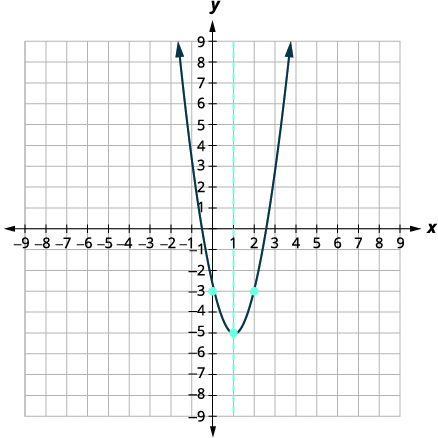 |
Exercise \(\PageIndex{17}\)
Graph \(f(x)=5 x^{2}+10 x+3\) by using its properties.
- Answer
-
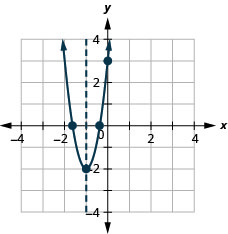
Exercise \(\PageIndex{18}\)
Graph \(f(x)=-3 x^{2}-6 x+5\) by using its properties.
- Answer
-
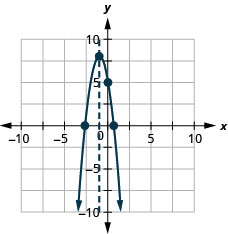
Solve Maximum and Minimum Applications
Knowing that the vertex of a parabola is the lowest or highest point of the parabola gives us an easy way to determine the minimum or maximum value of a quadratic function. The y-coordinate of the vertex is the minimum value of a parabola that opens upward. It is the maximum value of a parabola that opens downward. See Figure 9.6.124.

Minimum or Maximum Values of a Quadratic Function
The y-coordinate of the vertex of the graph of a quadratic function is the
- minimum value of the quadratic equation if the parabola opens upward.
- maximum value of the quadratic equation if the parabola opens downward.
Example \(\PageIndex{10}\)
Find the minimum or maximum value of the quadratic function \(f(x)=x^{2}+2 x-8\).
Solution:
| \(f(x)=x^{2}+2 x-8\) | |
| Since \(a\) is positive, the parabola opens upward. The quadratic equation has a minimum. | |
| Find the equation of the axis of symmetry. | \(x=-\frac{b}{2 a}\) |
| \(x=-\frac{2}{2 \times 1}\) | |
| \(x=-1\) | |
| The equation of the axis of symmetry is \(x=-1\). | |
| The vertex is on the line \(x=-1\). | \(f(x)=x^{2}+2 x-8\) |
| Find \(f(-1)\). |  |
| \(f(-1)=1-2-8\) | |
| \(f(-1)=-9\) | |
| The vertex is \((-1,-9)\). | |
| Since the parabola has a minimum, the \(y\)-coordinate of the vertex is the minimum \(y\)-value of the quadratic equation. The minimum value of the quadratic is \(-9\) and it occurs when \(x=-1\). | |
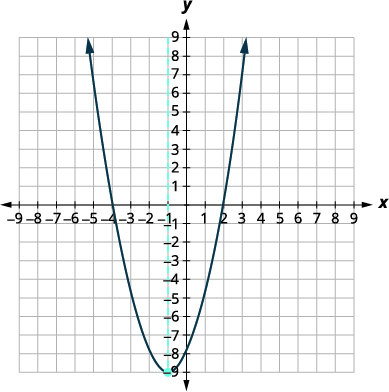 |
Show the graph to verify the result.
Exercise \(\PageIndex{19}\)
Find the maximum or minimum value of the quadratic function \(f(x)=x^{2}-8 x+12\).
- Answer
-
The minimum value of the quadratic function is \(−4\) and it occurs when \(x=4\).
Exercise \(\PageIndex{20}\)
Find the maximum or minimum value of the quadratic function \(f(x)=-4 x^{2}+16 x-11\).
- Answer
-
The maximum value of the quadratic function is \(5\) and it occurs when \(x=2\).
We have used the formula
\(h(t)=-16 t^{2}+v_{0} t+h_{0}\)
to calculate the height in feet, \(h\), of an object shot upwards into the air with initial velocity, \(v_{0}\), after \(t\) seconds .
This formula is a quadratic function, so its graph is a parabola. By solving for the coordinates of the vertex \((t,h)\), we can find how long it will take the object to reach its maximum height. Then we can calculate the maximum height.
Example \(\PageIndex{11}\)
The quadratic equation \(h(t)=-16 t^{2}+176 t+4\) models the height of a volleyball hit straight upwards with velocity \(176\) feet per second from a height of \(4\) feet.
- How many seconds will it take the volleyball to reach its maximum height?
- Find the maximum height of the volleyball.
Solution:
\(h(t)=-16 t^{2}+176 t+4\)
Since \(a\) is negative, the parabola opens downward. The quadratic function has a maximum.
a. Find the equation of the axis of symmetry.
\(\begin{array}{l}{t=-\frac{b}{2 a}} \\ {t=-\frac{176}{2(-16)}} \\ {t=5.5}\end{array}\)
The equation of the axis of symmetry is \(t=5.5\).
The vertex is on the line \(t=5.5\).
The maximum occurs when \(t=5.5\) seconds.
b. Find \(h(5.5)\).
\(\begin{array}{l}{h(t)=-16 t^{2}+176 t+4} \\ {h(t)=-16(5.5)^{2}+176(5.5)+4}\end{array}\)
Use a calculator to simplify.
\(h(t)=488\)
The vertex is \((5.5,488)\).
Since the parabola has a maximum, the \(h\)-coordinate of the vertex is the maximum value of the quadratic function.
The maximum value of the quadratic is \(488\) feet and it occurs when \(t=5.5\) seconds.
After \(5.5\) seconds, the volleyball will reach its maximum height of \(488\) feet.
Exercise \(\PageIndex{21}\)
Solve, rounding answers to the nearest tenth.
The quadratic function \(h(t)=-16 t^{2}+128 t+32\) is used to find the height of a stone thrown upward from a height of \(32\) feet at a rate of \(128\) ft/sec. How long will it take for the stone to reach its maximum height? What is the maximum height?
- Answer
-
It will take \(4\) seconds for the stone to reach its maximum height of \(288\) feet.
Exercise \(\PageIndex{22}\)
A path of a toy rocket thrown upward from the ground at a rate of \(208\) ft/sec is modeled by the quadratic function of \(h(t)=-16 t^{2}+208 t\). When will the rocket reach its maximum height? What will be the maximum height?
- Answer
-
It will take \(6.5\) seconds for the rocket to reach its maximum height of \(676\) feet.
Key Concepts
- Parabola Orientation
- For the graph of the quadratic function \(f(x)=a x^{2}+b x+c\), if
- \(a>0\), the parabola opens upward.
- \(a<0\), the parabola opens downward.
- For the graph of the quadratic function \(f(x)=a x^{2}+b x+c\), if
- Axis of Symmetry and Vertex of a Parabola The graph of the function \(f(x)=a x^{2}+b x+c\) is a parabola where:
- the axis of symmetry is the vertical line \(x=-\frac{b}{2 a}\).
- the vertex is a point on the axis of symmetry, so its \(x\)-coordinate is \(-\frac{b}{2 a}\).
- the \(y\)-coordinate of the vertex is found by substituting \(x=-\frac{b}{2 a}\) into the quadratic equation.
- Find the Intercepts of a Parabola
- To find the intercepts of a parabola whose function is \(f(x)=a x^{2}+b x+c\):
- \(y\)-intercept
- Let \(x=0\) and solve for \(f(x)\).
- \(x\)-intercepts
- Let \(f(x)=0\) and solve for \(x\).
- \(y\)-intercept
- To find the intercepts of a parabola whose function is \(f(x)=a x^{2}+b x+c\):
- How to graph a quadratic function using properties.
- Determine whether the parabola opens upward or downward.
- Find the equation of the axis of symmetry.
- Find the vertex.
- Find the \(y\)-intercept. Find the point symmetric to the y-intercept across the axis of symmetry.
- Find the \(x\)-intercepts. Find additional points if needed.
- Graph the parabola.
- Minimum or Maximum Values of a Quadratic Equation
- The \(y\)-coordinate of the vertex of the graph of a quadratic equation is the
- minimum value of the quadratic equation if the parabola opens upward.
- maximum value of the quadratic equation if the parabola opens downward.
Glossary
- quadratic function
- A quadratic function, where \(a, b\), and \(c\) are real numbers and \(a≠0\), is a function of the form \(f(x)=ax^{2}+bx+c\).

